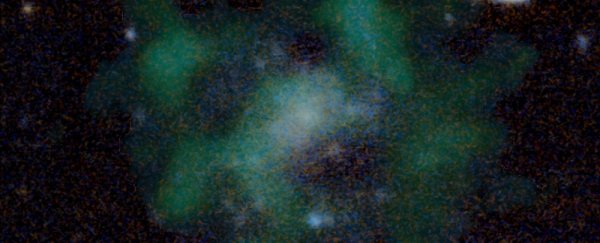A new discovery has deepened the mystery of galaxies without dark matter.
In a galaxy named AGC 114905, 250 million light-years away, astronomers could find no trace of the mysterious stuff, even after 40 hours of detailed observation and subsequent analysis.
The result, to be published in the Monthly Notices of the Royal Astronomical Society and available on preprint server arXiv, bolsters the case for galaxies mysteriously lacking in dark matter, even though it's vital for our models of galactic evolution.
"This is, of course, what we thought and hoped for because it confirms our previous measurements," said astronomer Pavel Mancera Piña of the University of Groningen and ASTRON in the Netherlands.
"But now the problem remains that the theory predicts that there must be dark matter in AGC 114905, but our observations say there isn't. In fact, the difference between theory and observation is only getting bigger."
Dark matter is one of the big mysteries of the Universe. We don't know what it is because we can't detect it directly, but we know there's some mass out there causing a range of effects in the Universe that can't be explained by normal matter alone.
Stars, for example, orbit their galaxies with a higher velocity than can be explained by the gravitational field of normal matter. The way the path of light bends as it travels through massive gravitational fields in intergalactic space is another.
Astronomers believe that dark matter helps galaxies form. There's an invisible dark matter web spanning the Universe, and the gravity it generates helps normal matter come together into galaxies. And, according to our models, dark matter also helps these galaxies stay together – a sort of cosmic binding agent.
But astronomers have been finding hints of galaxies without dark matter in recent years, in contravention of how we believe the Universe exists. So, when Mancera Piña and his colleagues found six galaxies seemingly without dark matter, described in a 2019 paper, they decided to take a much closer look.
AGC 114905 is what we call an ultra diffuse dwarf galaxy. It's about the size of the Milky Way, but much, much less luminous, containing far fewer stars – around a thousand times fewer. Because they have so little normal matter, it's thought that these galaxies ought to be held together by dark matter.
So the researchers took a closer look at AGC 114905 using the NRAO's Very Large Array in New Mexico, obtaining a total of 40 hours worth of observation data at a much higher spatial resolution. Then, they very carefully plotted the rotation curve of the galaxy – the orbital speed of the objects in AGC 114905, plotted against their distance from the galactic center.
This is one of the most common methods for calculating the amount of dark matter in a galaxy: objects orbiting too quickly can be explained by adding dark matter, and the amount of dark matter influences the additional orbital velocity.
But the rotation curve of AGC 114905 doesn't require the presence of dark matter. It can be explained simply by the amount of normal matter alone. This means that the amount of dark matter in the galaxy appears to be negligible.
And this poses a dilly of a pickle because none of the explanations for the lack of dark matter seem to fit. One explanation, for instance, would be if a nearby massive galaxy had stripped AGC 114905 of its dark matter, as seems to be the case of another diffuse galaxy discovered to have no dark matter, DF4.
"But there are none," Mancera Piña said. "And in the most reputed galaxy formation framework, the so-called cold dark matter model, we would have to introduce extreme parameter values that are far beyond the usual range. Also, with modified Newtonian dynamics, an alternative theory to cold dark matter, we cannot reproduce the motions of the gas within the galaxy."
In cases of other galaxies with abnormal amounts of dark matter, it could be that we have simply misjudged the distances. But the distance to AGC 114905, the researchers said, is well constrained.
It's possible, researchers concede, that the estimated observation angle could be off; that could explain the apparent lack of dark matter. But it would have to be off, they said, by quite a huge margin.
In addition, all six galaxies from their initial studies all showed similar behavior, at a range of different inclinations. This suggests that the behavior is not the result of a systematic error, they said. They are currently conducting a detailed follow-up on a second ultra-diffuse galaxy to try and get to the bottom of it.
If confirmed, their findings could have very interesting implications for our understanding of galactic evolution.
"We have strengthened and clarified previous results on the nature and startling dynamics of gas-rich ultra-diffuse galaxies. Yet, their origin and precise evolutionary pathways remain largely a mystery," the researchers wrote in their paper.
The present work has also shown that gas-rich ultra-diffuse galaxies are a promising population to study dark matter, as they can potentially provide telltale clues to understand its nature."
The research is due to appear in the Monthly Notices of the Royal Astronomical Society and is available on arXiv.
